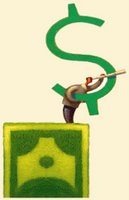2014 Prime Rate Forecast: Prime Very Likely To Contiue At 3.25% All Year
 Here's a clip from today's Federal Open Market Committee (FOMC) monetary policy release:
Here's a clip from today's Federal Open Market Committee (FOMC) monetary policy release: "...Beginning in January [2014], the Committee will add to its holdings of agency mortgage-backed securities at a pace of $35 billion per month rather than $40 billion per month, and will add to its holdings of longer-term Treasury securities at a pace of $40 billion per month rather than $45 billion per month..."So the Fed has decided to lift its foot off the money-printing pedal next month, just a little bit, and will buy $75 billion of debt per month, instead of $85 billion.
Wall Street reacted positively to the Fed's decision to begin tapering its bond-buying program, with both the Dow Jones Industrial Average (DJIA) and the S and P 500 Index closing with new record highs today.
Scaling back on bond buying, after all, means that the Fed is confident that the economy will continue to improve.
Wall Street was also cheered by the Fed's solid language regarding short-term rates; another clip:
In other words, the Fed is going to keep short-term rates (which includes the US Prime Rate) in the deep freeze until the economy is very firmly in escape-velocity mode, and is willing to risk some inflation down the road to get there.
"...The Committee now anticipates, based on its assessment of these factors, that it likely will be appropriate to maintain the current target range for the federal funds rate well past the time that the unemployment rate declines below 6-1/2 percent, especially if projected inflation continues to run below the Committee's 2 percent longer-run goal..."
The United States Prime Rate is essentially a function of the fed funds target rate:
And , at 3-1/4%, the Prime is currently as low as it can go.
Month after month after month of strong, non-farm payrolls, with 2% inflation on the side. That's what the Fed is looking for.
Earlier today, the FOMC also released projections for the benchmark fed funds target rate. Out of 17 participants, only 2 are forecasting a increase for the fed funds target rate at some point during 2014, with 15 predicting that the FOMC will leave it where it is right now (range of 0%-0.25%.)
 |
| Dr. Janet L. Yellen |
Her challenges are many, and the scrutiny will be intense. Continuing to steer and eventually complete the economic recovery which Ben Bernanke started will be no picnic, with the headwind of a dysfunctional Congress and a virtually empty toolbox.
But if anyone has the brains and background to get the job done, it's Dr. Yellen.
Ben Bernanke is a clever economist too.
But, despite being an expert on the Great Depression, Dr. Bernanke hasn't been able to get the US economy back to full strength, and he's had four years to try.
Moreover, Fed Boss Bernanke was late in his reaction to the banking crisis and subsequent housing crash, a tardiness that may have contributed to the protracted nature of the worse recession since the big one back in 1929.
Let's see if Dr. Yellen can figure out how to get banks to stop sitting on their massive piles of cash, and lend to deserving businesses and entrepreneurs.
Mortgage Rate Forecast
If the economic recovery continues at a strong and sustained pace, investors will continue to rotate out of the safety of government debt, and move to riskier assets like stocks.
If that happens, US Treasury yields will rise, which will cause mortgage rates to rise (rates associated with 30-year, fixed-rate mortgages track very closely with the yield on the Ten-Year U.S. Treasury Note.)
If the recovery peters out, then investors will scramble back to government bonds, and mortgage rates will fall.
Anyone who thinks that they can offer a more accurate prediction of American mortgage rates, will probably try to sell you a popular and vintage bridge in Brooklyn next....
From the rate watchers here @ www.FedPrimeRate.com: All the best for 2014.
As of right now, the investors who trade in fed funds futures at the Chicago Board of Trade have odds at 100% (as implied by current pricing on contracts) that the Federal Open Market Committee (FOMC) will vote to leave the benchmark target range for the Federal Funds Rate at its current level at the January 29TH, March 19TH and April 30TH, 2014 FOMC monetary policy meetings.
Summary of the Latest Prime Rate Forecast:
- Current odds that the Prime Rate will remain at the current 3.25% after the January 29TH, March 19TH and April 30TH, 2014 FOMC monetary policy meetings are adjourned: 100% (certain)
- NB: U.S. Prime Rate = (The Federal Funds Target Rate + 3)
The odds related to federal-funds futures contracts -- widely accepted as the best predictor of where the FOMC will take the benchmark Fed Funds Target Rate -- are constantly changing, so stay tuned for the latest odds.
Labels: 2014, banking_crisis, financial_crisis, great_recession, great_rotation, mortgage, mortgage_rate_forecast, mortgage_rate_prediction, mortgage_rates, odds, prime_rate_forecast, prime_rate_prediction, taper
|
--> www.FedPrimeRate.com Privacy Policy <--
--> www.FedPrimeRate.com Privacy Policy -- BACKUP<-- CLICK HERE to JUMP to the TOP of THIS PAGE > SITEMAP < |





